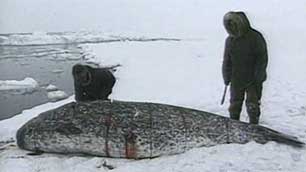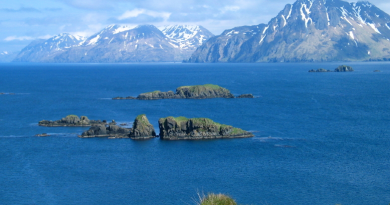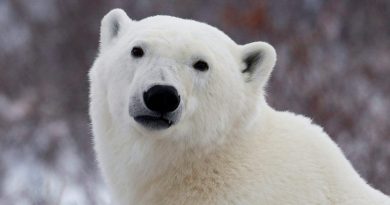Canadian Federal Narwhal Tusk Export Ban Defended
 Canadian federal fisheries officials are defending their ban on the international export of narwhal tusks from 17 Nunavut communities, despite an outcry from Inuit who trade tusk ivory for income.
Canadian federal fisheries officials are defending their ban on the international export of narwhal tusks from 17 Nunavut communities, despite an outcry from Inuit who trade tusk ivory for income.
The Department of Fisheries and Oceans says it has imposed restrictions on the export of narhwal tusks from Iqaluit and other communities because narwhal in those areas are being overhunted.
Inuit have long hunted the Arctic whale for its skin and blubber, a food source. To earn extra income, whalers also hunt male narwhal for their heavy spiralling tusks that jut upwards of three metres from the jaw.
But DFO officials say if Canada does not restrict the export of those tusks, then the international community may ban exports altogether under the Convention on the International Trade in Endangered Species (CITES).
“We felt that if we didn’t respond to the science advice, as we should, and we didn’t meet our international obligations, we could certainly find ourselves at CITES facing a complete ban on exports from Canada,” Sylvie Lapointe, the department’s director of international fisheries management, told CBC News.
An average of 120 narwhal tusks are sold overseas every year, Lapointe estimated.
According to DFO, four of six narwhal populations in Canada are considered to be at risk due to overhunting or a lack of current information:
- East Baffin Island.
- Admiralty Inlet.
- Northern Hudson Bay.
- Parry Channel, Jones Sound and Smith Sound.
Whalers in Kugaaruk, Taloyoak, Gjoa Haven, Igloolik and Pond Inlet are still permitted to export tusks internationally. DFO says narwhal stocks are abundant in Somerset Island and Eclipse Sound.
Inuit in the 17 communities affected by the ban are still allowed to sell their tusks within Canada, but they cannot obtain export permits to sell them outside the country.
Lapointe said the trade restrictions will stay in place until the hunting of narwhal decreases, or until new surveys show whale populations are growing.
Inuit group considers legal action
Nunavut’s Inuit land-claims organization, Nunavut Tunngavik Inc., argues that the trade restrictions violate Inuit harvesting rights. The group is considering legal action.
“We would like DFO to explain themselves, come up to the communities that are affected and explain their rationale,” said Gabriel Nirlungayuk, Nunavut Tunngavik’s director of wildlife.
Nirlungayuk said the federal department is basing is decision on old and incomplete data. As well, he said DFO did not consult with Inuit before the restrictions were imposed.
“We regularly consult with the Inuit, numerous times over the years with respect to questions of science and management as they relate to narwhal,” Lapointe countered.
“The basis for the decision that we took was followed from all of those various consultative processes that we have under the land claims agreement.”
But Western Arctic NDP MP Dennis Bevington said DFO should have consulted more with Inuit who would be affected by the trade ban.
“Before you ban our communities from accessing this resource, the narwhal, you come and talk to us and you work with us to ensure that the scientific data that you’re using is appropriate with our traditional knowledge,” Bevington told reporters in Ottawa on Thursday.
“Once again, we’re seeing that the government’s not following through with proper consultation with traditional harvesters that have used this resource for centuries.”
Some narwhal surveys in the four affected areas date back several years. The latest one was conducted earlier this year in Admiralty Inlet, but the results are not in yet, according to officials.
Affected communities
The narwhal tusk export ban introduced by the Department of Fisheries and Oceans applies to 17 Nunavut communities:
Grise Fiord. Arctic Bay. Resolute Bay. Clyde River. Qikiqtarjuaq. Pangnirtung. Iqaluit. Kimmirut. Cape Dorset. Coral Harbour. Repulse Bay. Hall Beach. Chesterfield Inlet. Rankin Inlet. Whale Cove. Arviat. Sanikiluaq.
(Source: Nunavut Tunngavik Inc.)
Affected communities
The narwhal tusk export ban introduced by the Department of Fisheries and Oceans applies to 17 Nunavut communities:
Grise Fiord. Arctic Bay. Resolute Bay. Clyde River. Qikiqtarjuaq. Pangnirtung. Iqaluit. Kimmirut. Cape Dorset. Coral Harbour. Repulse Bay. Hall Beach. Chesterfield Inlet. Rankin Inlet. Whale Cove. Arviat. Sanikiluaq.
(Source: Nunavut Tunngavik Inc.)



